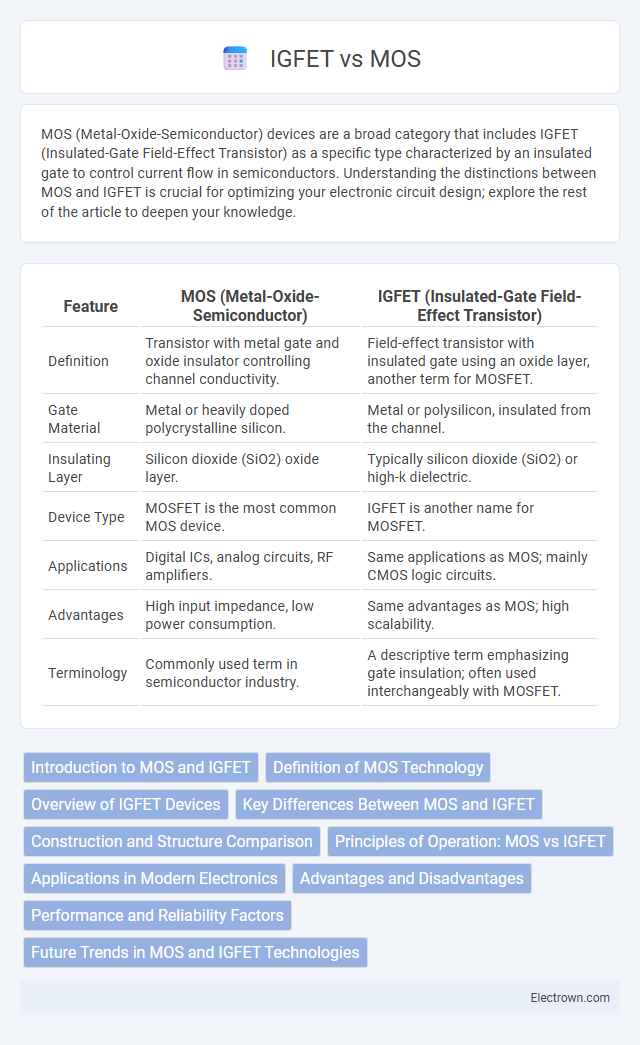MOS (Metal-Oxide-Semiconductor) devices are a broad category that includes IGFET (Insulated-Gate Field-Effect Transistor) as a specific type characterized by an insulated gate to control current flow in semiconductors. Understanding the distinctions between MOS and IGFET is crucial for optimizing your electronic circuit design; explore the rest of the article to deepen your knowledge.
Table of Comparison
| Feature | MOS (Metal-Oxide-Semiconductor) | IGFET (Insulated-Gate Field-Effect Transistor) |
|---|---|---|
| Definition | Transistor with metal gate and oxide insulator controlling channel conductivity. | Field-effect transistor with insulated gate using an oxide layer, another term for MOSFET. |
| Gate Material | Metal or heavily doped polycrystalline silicon. | Metal or polysilicon, insulated from the channel. |
| Insulating Layer | Silicon dioxide (SiO2) oxide layer. | Typically silicon dioxide (SiO2) or high-k dielectric. |
| Device Type | MOSFET is the most common MOS device. | IGFET is another name for MOSFET. |
| Applications | Digital ICs, analog circuits, RF amplifiers. | Same applications as MOS; mainly CMOS logic circuits. |
| Advantages | High input impedance, low power consumption. | Same advantages as MOS; high scalability. |
| Terminology | Commonly used term in semiconductor industry. | A descriptive term emphasizing gate insulation; often used interchangeably with MOSFET. |
Introduction to MOS and IGFET
MOS (Metal-Oxide-Semiconductor) and IGFET (Insulated-Gate Field-Effect Transistor) refer to similar transistor technologies used in modern electronics. The IGFET is an early term describing transistors with an insulated gate, while MOS transistors specifically emphasize the metal gate, oxide insulation, and semiconductor channel structure. Understanding the differences in terminology helps clarify your grasp of transistor design and fabrication principles.
Definition of MOS Technology
MOS technology, standing for Metal-Oxide-Semiconductor, is a widely used semiconductor fabrication process that forms the basis of most modern integrated circuits by utilizing a metal gate, an oxide insulator, and a semiconductor substrate. In MOS transistors, a thin oxide layer separates the metal gate from the underlying semiconductor, enabling voltage-controlled conductivity channels that make these devices essential for digital and analog circuits. Compared to IGFET (Insulated-Gate Field-Effect Transistor), MOS technology specifically emphasizes the oxide layer's role in enhancing device performance, reliability, and scaling in microelectronics.
Overview of IGFET Devices
IGFET (Insulated Gate Field Effect Transistor) devices function by controlling current flow through an electric field applied to a gate insulated from the semiconductor channel, offering high input impedance and low power consumption. Unlike MOS devices, IGFETs emphasize gate insulation quality and feature gate materials that influence threshold voltage and device reliability. Understanding IGFET technology helps you optimize electronic circuit designs where switching performance and signal integrity are critical.
Key Differences Between MOS and IGFET
MOS (Metal-Oxide-Semiconductor) and IGFET (Insulated-Gate Field-Effect Transistor) are fundamentally similar transistors used in modern electronics, but the key differences lie in their terminology and historical context. MOS is a broad category that includes IGFETs, where IGFET specifically refers to the transistor type using an insulated gate to control current flow. Your understanding of semiconductor devices benefits from distinguishing MOS as the overarching technology, with IGFET representing its specific implementation in field-effect transistors.
Construction and Structure Comparison
MOS (Metal-Oxide-Semiconductor) and IGFET (Insulated-Gate Field-Effect Transistor) share similar construction, consisting of a semiconductor substrate, a thin oxide insulating layer, and a metal or polysilicon gate electrode. The key structural difference lies in the gate material where MOS traditionally uses metal, whereas IGFET typically employs polysilicon, enhancing compatibility with silicon processing. Both devices utilize the insulated gate to control the channel conductivity, but IGFET's structure often leads to improved scalability and integration in modern CMOS technology.
Principles of Operation: MOS vs IGFET
MOS (Metal-Oxide-Semiconductor) and IGFET (Insulated-Gate Field-Effect Transistor) operate on similar principles by using an electric field to control the conductivity of a semiconductor channel. The MOS transistor uses a metal gate with an oxide insulator to modulate the electron flow between source and drain terminals, whereas the IGFET specifically refers to the insulated gate structure controlling current without direct gate-to-channel contact. Both devices rely on field effect modulation, with IGFET being a subclass of MOS devices that emphasize the insulated-gate mechanism for enhanced switching performance.
Applications in Modern Electronics
MOS (Metal-Oxide-Semiconductor) transistors dominate modern electronics due to their low power consumption and high switching speed, making them ideal for integrated circuits in microprocessors, memory devices, and digital logic applications. IGFET (Insulated-Gate Field-Effect Transistor) technology, a subset of MOSFETs, is widely employed in analog circuits and power management systems because of its excellent voltage control and efficiency. The scalability and reliability of MOS and IGFET devices drive advancements in smartphones, computers, and consumer electronics.
Advantages and Disadvantages
MOS (Metal-Oxide-Semiconductor) transistors offer advantages like low power consumption, high input impedance, and easy integration in ICs, making them ideal for digital circuits. IGFET (Insulated-Gate Field-Effect Transistor), a type of MOSFET, provides precise control with voltage-driven operation, but can suffer from sensitivity to oxide defects and lower current drive compared to BJTs. Your choice depends on balancing efficiency, switching speed, and fabrication complexity.
Performance and Reliability Factors
MOS (Metal-Oxide-Semiconductor) transistors generally offer higher performance due to lower power consumption and faster switching speeds compared to IGFET (Insulated-Gate Field-Effect Transistor) devices, which often suffer from increased threshold voltage variability. Reliability in MOS devices is enhanced by superior oxide layer quality and reduced susceptibility to leakage currents, whereas IGFET structures can experience higher degradation rates from hot-carrier injection and oxide trap formation. Careful optimization of gate oxide thickness and doping concentrations in MOS technology leads to improved device longevity and consistent electrical characteristics under varying operational stresses.
Future Trends in MOS and IGFET Technologies
Future trends in MOS and IGFET technologies emphasize continued scaling down of transistor dimensions to enhance performance and energy efficiency in semiconductor devices. Advancements in materials, such as high-k dielectrics and novel channel materials like graphene, are driving improvements in carrier mobility and reducing leakage currents. You can expect these innovations to enable faster, smaller, and more power-efficient integrated circuits critical for next-generation computing and communication systems.
MOS vs IGFET Infographic

 electrown.com
electrown.com